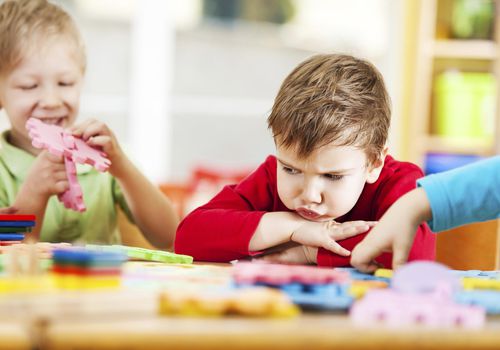Smart Look Up
- Classroom tantrums can come in the form of screaming, throwing oneself on the floor or even hitting others
- Knowing and reading in between the lines for triggers is a good start for managing classroom tantrums
- For the purposes of this article, the words: tantrums, meltdown and outburst will be used interchangeably to mean losing one’s temper in a noisy and uncontrolled way
“Could it have gotten any worse? This boy will just not sit down, see the mess you have created now” – frustrated Hilda, a preschool facilitator.
“Oooh! Adepa, Adepa, Adepa. I just do not know how to handle her any longer. I have even run out of ways to lure and pin her down, as hard as I try, she just cannot be won over.” – Cicci, a lower primary facilitator.
When was the last time you identified with any of the experiences of Hilda and Akosua? Dealing with tantrums in the classroom can be one of the most daunting tasks, among others, that a facilitator most especially would have to deal with almost every day of the school week. Classroom tantrums may be presented in various forms which may include screaming, throwing oneself on floor, hitting, biting or even simply crying or wanting to own particular objects in the classroom environment.
Whatever the reason for a child’s tantrums, the facilitator is thrown into a state of confusion of a sort, as he or she needs to find ways of dealing with the outburst, while getting other members of the class at rest. Without a doubt, this may seem like a backbreaking task, but let us consider what you can do before the moment, during the moment and after the moment?
Today’s article will help us find practical ways to deal with classroom tantrums without destroying, harming or attacking a child’s character.
Before the moment
Now here is what you can do before a tantrum or an outburst is triggered.
It will be prudent to have an open discussion about emotions in a more pleasant and friendly setting. In such a setting, your learners or children would have the opportunity to openly talk about their emotions and how to deal with them in a positive way when they become frustrated or upset. Remember to keep the discussion warm, friendly and fun.
So, you can set a time on the class time table when your learners are more at ease to cooperate and have a discussion. Then, you can use an age-appropriate emotions or ‘emoji’ chart to have a fun and creative discussion on how to positively deal with emotions. Dealing or discussing one emotion at a time will be more impactful and beneficial to both the learner and the facilitator.
When you take the time to know your learners by talking often about their likes and dislikes, what makes them happy or sad, take note of the part of the day that is toughest for them and rightly interpret their body language, you will most likely notice when a meltdown is about to start.
Here is what Hilda, mentioned in the opening comments section of this article, observed about one of her learners; “it is very funny how the learners in my class behave when it is almost time for lunch. Willie in particular will start to cry and even begin to hit other learners in the class. This, I have come to learn is a sign that he is hungry. So some minutes before lunch time, I get Willie to drink some water and this calms him down. When he also lends a hand with bringing in the meal, he is super excited, and that means no triggers for a tantrum.”
Hilda’s approach might seem pretty interesting, but cannot be a one-size-fit-all for every learner. That is why it is very necessary to know what possibly appeals to each learner and play along, allowing them to take the lead in a way, just to avoid the meltdowns.
Many tantrums begin because a child is bored, tired or hungry, so it is very important to pay attention and keep a close eye on their activities throughout the day. If you give attention to the signs, you will be able to offer a child what they need before a possible outburst is triggered.
Distracting a child’s attention away from the negative emotions can also help. Asking a question as simple as ‘how are you feeling?’ can draw a child’s attention away from his or her negative emotions. Toys are also a great distraction for children.
During the moment
As earlier discussed, we have come to see some practical ways in which a possible tantrum can be prevented. That, however, does not mean tantrums will never occur. Here is what to do when tempers rise and the mountains begin to tumble down.
Most important among other things is to keep everyone safe and pull yourself together. Seemingly impossible right? We need to be mindful that some children throw things around when they are having an outburst. Therefore, you need to do well to keep the child on ‘display’ safe. You can do this by, bringing him or her away from hard, pointed edges and objects that could harm himself or anyone else in the classroom. It is only then that you can move on to keep the other class members at rest. If the circumstance would allow, you can go on and keep the others involved in a fun or favourite class activity. For example, building blocks or Legos.
Here is a point worth noting; childcare experts have it that losing your temper and matching the child’s anger is the worst thing you can do during an outburst. Trying to calm down in the midst of a child throwing tantrums is definitely not a cozy wind to sail, but it would do a lot of good to keep this in mind: that those tantrums are normal with growing children, and their behaviour is to be expected. It is also very critical to know how important it is to deal with tantrums in a way that will positively correct a child on how to deal with emotions and not attack a child’s character.
Cicci later had this to say about her lower primary learner who was tough to deal with: “Learning to overcome my emotions and not matching mine to that of Adepa has helped me to know how to positively help her to deal with those emotions. Seeing her as a child behaviour is not out of the way for growing children, helps me calm down. I now deal more patiently with her as a child.”
When children are overstimulated or frustrated, removing them from the environment can give them space to work through their feelings without becoming even more upset. This is not to say the child is to be removed from the environment and left unattended to, NO! But, “Having a quiet space gives children a sense of control and a place to disengage from whatever triggered the tantrum to begin with”, says Adeosun. She recommends designating a calm area that children know they can visit if needed.
When adults are upset, it helps to talk through their problems with a friend who listens. The same is true of children. “Get down on their level and quietly let them know that you understand how they are feeling”, says Kuhn. You can respond if they talk to you, but don’t attempt to force a reply. Your most important role is to listen.
After the moment
After journeying through the previous phases of managing a tantrum, talking about what just happened may not be your first instinct, but it is the best course of action to help children understand how to work through their feelings.
It would be good to talk through what just happened with the entire class for them to understand what happened and why you had to take some time to handle it the way you did. You can also tell them how it will benefit the child in question and themselves as well.
It has become important for children to understand that their friends may have trouble
with certain things, like sharing. But having regular, honest conversations about why we
feel the way we do, will put them in a better position to understand how their friends feel
when they have a tantrum. “An empathetic child will be able to be kind, respectful and
helpful in times of tantrums,” says Kuhn.
Afterall said and done, you now have to get the class back on track and teach.
In plain words, dealing with tantrums is not easy; nonetheless, when next you have to manage one, think of safety, stay calm and be prepared to assist your learners or children to work through their meltdowns.
Tantrums are inevitable, but you can still stay in control of your classroom.
DO YOU REMEMBER?
It will be prudent to have an open discussion with your learners about emotions in a more pleasant and friendly setting.
Most important among other things to do during a tantrum, is to keep everyone safe and pull yourself together
Tantrums are inevitable, but you can still stay in control when you take time to know your leaners, pay attention to their behaviour and master the act of distraction.










